The Intel Xeon W-3175X Review: 28 Unlocked Cores, $2999
by Ian Cutress on January 30, 2019 9:00 AM ESTCPU Performance: Office Tests
The Office test suite is designed to focus around more industry standard tests that focus on office workflows, system meetings, some synthetics, but we also bundle compiler performance in with this section. For users that have to evaluate hardware in general, these are usually the benchmarks that most consider.
All of our benchmark results can also be found in our benchmark engine, Bench.
For our graphs, some of them have two values: a regular value in orange, and one in red called 'Intel Spec'. ASUS offers the option to 'open up' the power and current limits of the chip, so the CPU is still running at the same frequency but is not throttled. Despite Intel saying that they recommend 'Intel Spec', the system they sent to us to test was actually set up with the power limits opened up, and the results they provided for us to compare to internally also correlated with that setting. As a result, we're providing both sets results for our CPU tests.
PCMark 10: Industry Standard System Profiler
Futuremark, now known as UL, has developed benchmarks that have become industry standards for around two decades. The latest complete system test suite is PCMark 10, upgrading over PCMark 8 with updated tests and more OpenCL invested into use cases such as video streaming.
PCMark splits its scores into about 14 different areas, including application startup, web, spreadsheets, photo editing, rendering, video conferencing, and physics. We post all of these numbers in our benchmark database, Bench, however the key metric for the review is the overall score.
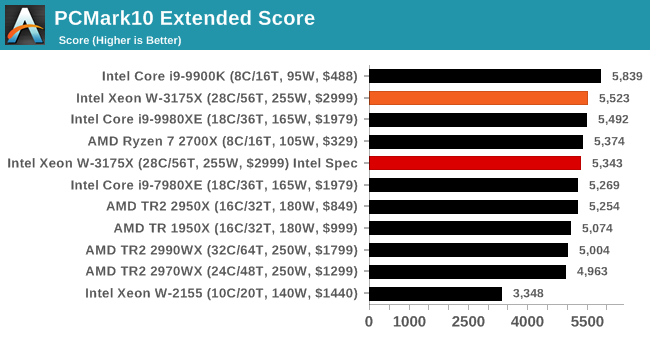
.
Chromium Compile: Windows VC++ Compile of Chrome 56
A large number of AnandTech readers are software engineers, looking at how the hardware they use performs. While compiling a Linux kernel is ‘standard’ for the reviewers who often compile, our test is a little more varied – we are using the windows instructions to compile Chrome, specifically a Chrome 56 build from March 2017, as that was when we built the test. Google quite handily gives instructions on how to compile with Windows, along with a 400k file download for the repo.
In our test, using Google’s instructions, we use the MSVC compiler and ninja developer tools to manage the compile. As you may expect, the benchmark is variably threaded, with a mix of DRAM requirements that benefit from faster caches. Data procured in our test is the time taken for the compile, which we convert into compiles per day.
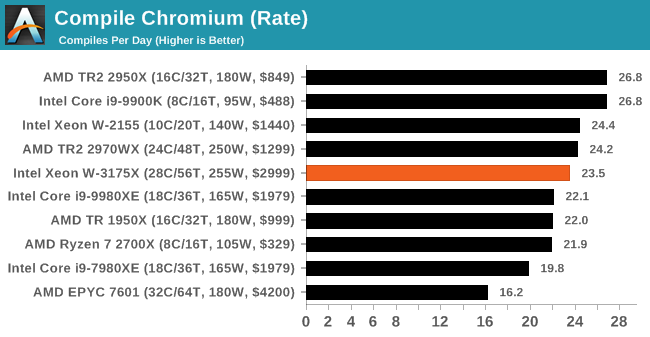
.
3DMark Physics: In-Game Physics Compute
Alongside PCMark is 3DMark, Futuremark’s (UL’s) gaming test suite. Each gaming tests consists of one or two GPU heavy scenes, along with a physics test that is indicative of when the test was written and the platform it is aimed at. The main overriding tests, in order of complexity, are Ice Storm, Cloud Gate, Sky Diver, Fire Strike, and Time Spy.
Some of the subtests offer variants, such as Ice Storm Unlimited, which is aimed at mobile platforms with an off-screen rendering, or Fire Strike Ultra which is aimed at high-end 4K systems with lots of the added features turned on. Time Spy also currently has an AVX-512 mode (which we may be using in the future).
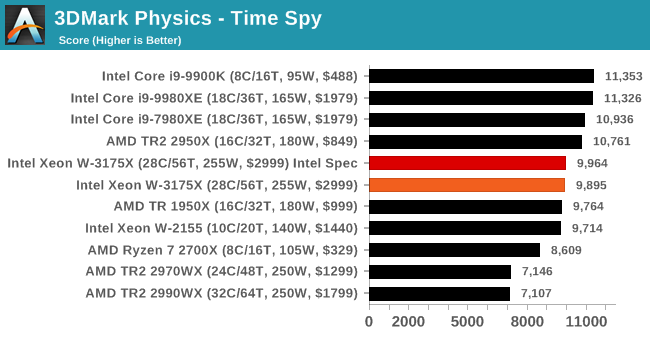
.
GeekBench4: Synthetics
A common tool for cross-platform testing between mobile, PC, and Mac, GeekBench 4 is an ultimate exercise in synthetic testing across a range of algorithms looking for peak throughput. Tests include encryption, compression, fast Fourier transform, memory operations, n-body physics, matrix operations, histogram manipulation, and HTML parsing.
I’m including this test due to popular demand, although the results do come across as overly synthetic, and a lot of users often put a lot of weight behind the test due to the fact that it is compiled across different platforms (although with different compilers).
We record the main subtest scores (Crypto, Integer, Floating Point, Memory) in our benchmark database, but for the review we post the overall single and multi-threaded results.
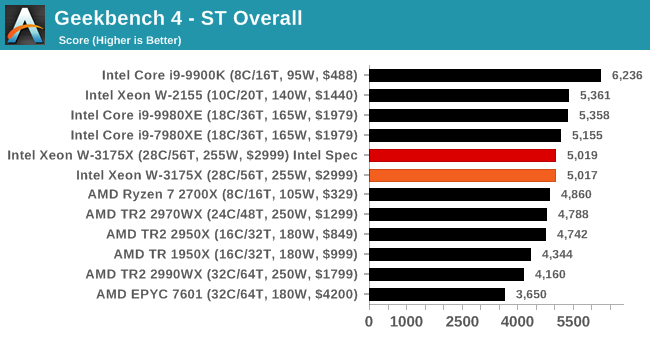
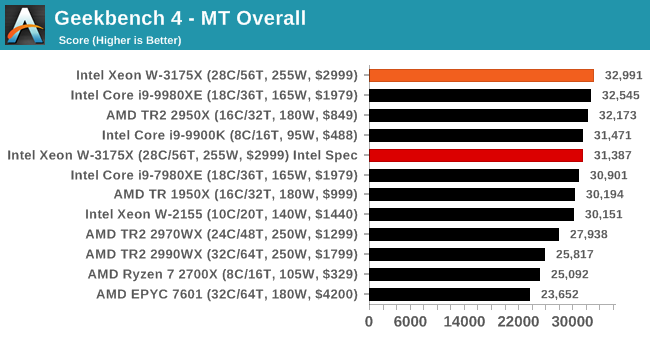










136 Comments
View All Comments
eva02langley - Thursday, January 31, 2019 - link
Forget to mention Omnium Gatherum - The Burning ColdPeachNCream - Thursday, January 31, 2019 - link
"On the power side of the equation, again the W-3175X comes in like a wrecking ball, and this baby is on fire."It's more like a Miley Cyrus licking a sledgehammer thing to me.
sgeocla - Wednesday, January 30, 2019 - link
Computex 2018: Intel 28 core 5 Ghz out by end of year.February 2019: Intel 28 core 4.5 Ghz, costs 70% more than competing product.
Intel is early on promises and late on delivery as always.
BigMamaInHouse - Wednesday, January 30, 2019 - link
The CPU is 3000$ + 1500$ MB+ ECC + eXtreme case/PSU/AIO.Thanks Ian Cutress for the honest review!
(unlike "JustBuyIt that gave this fail product(Total System) 4.5/5 rating vs 2990WX 3.5/5 because its expensive!")
Morawka - Wednesday, January 30, 2019 - link
oh wow, i didn't realize the Dominus Extreme was so expensive.tamalero - Wednesday, January 30, 2019 - link
We're getting a ton of "sponsored" BS articles lately that are cynical.eva02langley - Thursday, January 31, 2019 - link
WCCFtech gave the MSI 2080 TI lightning 1600$ GPU a 10/10 for value...FMinus - Friday, February 1, 2019 - link
RX 570 is 10/10 along with maybe the GTX 1060, everything else is going down the value ladder pretty fast from that point on. For any consumer/gaming oriented GPU that passes the $500 mark I'd give it -1/10 value score.DanNeely - Wednesday, January 30, 2019 - link
The on stage demo was using a chilled water setup, that they managed to push that system higher than Ian could with room temperature water is only to be expected.jardows2 - Wednesday, January 30, 2019 - link
This seems like a really good processor for a productivity station. I think, especially at the expected price, it would sell really well. That has me puzzled then as to why Intel would have such a limited run. The supposed figures is barely enough to send to review sites around the world, let alone have a profitable product line. If they produced 10X the amount of these, they'd probably sell them all. Why is Intel leaving easy money on the table? Something doesn't seem right about this picture.